Too many leaders labor under the pernicious paradigm that people are interchangeable, that one worker equals another, that they can easily replace one person with another person.
Or leaders toss out the dull cliché that “our people are our most important assets.” But people are not assets. An asset is something you own — a human being cannot be treated like a machine.
Given enough support, any human being has virtually limitless power.
The old industrial paradigm that an employee is an interchangeable cog in the machine is the most important reason why people are disengaged in the workplace, refusing to give the “extra effort.” That’s why the most important job to be done now is to replace that paradigm with a new paradigm: that every person is uniquely powerful. Your job as a leader is to unleash that power.
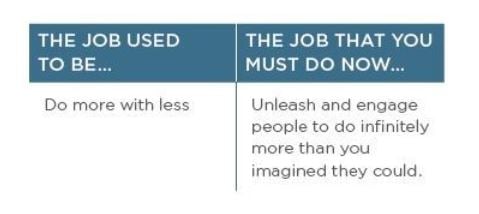 FranklinCovey has been the leader in time management for many years. We’ve trained more than 25 million people and enabled that learning with our famous Franklin Planner tools. But today’s productivity problems go far deeper than just managing units of time. In the Knowledge Worker Age, we have specific challenges that can leave us feeling unaccomplished and weary at the end of the day.
FranklinCovey has been the leader in time management for many years. We’ve trained more than 25 million people and enabled that learning with our famous Franklin Planner tools. But today’s productivity problems go far deeper than just managing units of time. In the Knowledge Worker Age, we have specific challenges that can leave us feeling unaccomplished and weary at the end of the day.
Productivity Problem 1: We're Making More Decisions Than Ever
During the Industrial Age, workers on an assembly line put one part on one machine a hundred times a day. They had few choices and fewer decisions to make.
As knowledge workers, we no longer stand in an assembly line doing repetitive tasks. We have comparatively unlimited decisions about what to work on, when, and how (“Do I answer this email? Accept this meeting invitation? Work on this project or that one?”). We do our best to handle decisions as they come in, but the decisions we are required to make are complex and have high value.
One of our clients told us that her sales organization was overrun with emails, fires to put out, and other demands. When asked which activities drove sales, she explained that demonstrations led to the greatest closing rate. But even though her teams were fully aware of this, they were so “busy” they didn’t feel they had time for their highest priority: delivering demonstrations.
Productivity Problem 2: Our Attention Is Under Unprecedented Attack
Thanks to technology, the information explosion is almost incomprehensibly huge. By the end of the twentieth century, the entire sum of information produced since the dawn of civilization was about twelve exabytes. We now produce this much information in about four days!
The fact that our brain loves the novelty of those dings and pings, which creates an addiction to technology, doesn’t help. Thus the paradox: Technology makes our lives easier, more effective, and more efficient, but it also distracts us and overburdens us.
Productivity Problem 3: We Suffer From A Personal Energy Crisis
Problems 1 and 2 are wearing us out. We no longer work a standard eight-hour day. Our minds are constantly churning, trying to make high-value decisions, virtually twenty-four hours a day. The way most of us live our lives today — constant stress, poor diet, and lack of exercise and sleep — leads to what scientists call “exhaustion syndrome.” The rest of us call it burnout. And we get rewarded for this mindset; it becomes a badge of honor.
Some leaders will shrug these problems off, saying, “This is just the world we live in. Deal with it.” But highly effective leaders realize the costs. They equip their people with twenty-first-century mindsets, skillsets, and toolsets that will help them feel highly accomplished every day.
The 5 Steps to Unleash Productivity:
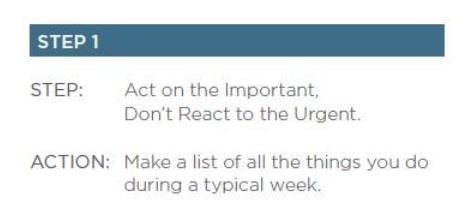 Draw four boxes that look like this. Label the boxes as indicated.
Draw four boxes that look like this. Label the boxes as indicated.
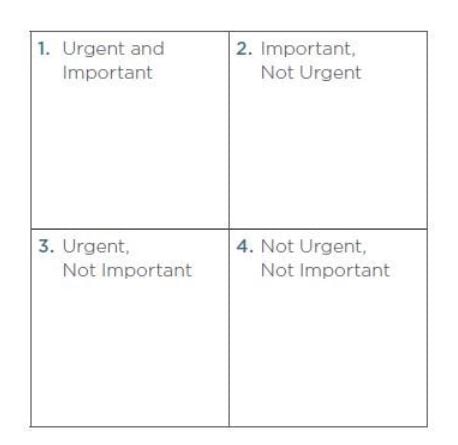 Drop each action item from your Action List into one of the four boxes. Then follow these recommendations:
Drop each action item from your Action List into one of the four boxes. Then follow these recommendations:
Box 1
-
-
-
-
-
- Action Items: Important and urgent things, like putting out fires, taking care of emergencies, meeting close deadlines, etc.
- Recommendation: Analyze how to prevent them in the future. You will see that many of the things in Quadrant 1 could have been avoided if you had prepared for them.
Box 2 - Action Items: Important but not urgent things, like planning your time, working on long-term goals, preventing future crises, reading, and learning.
- Recommendation: Focus your best time and energies here. If you do, you will have plenty of time for the things that really matter.
Box 3 - Action Items: Unimportant things that are urgent, like some requests from other people, meetings you’ve been invited to but don’t really need to attend, etc.
- Recommendation: Say no when possible to these things. A lot of what people ask you to do might not contribute to your top goals and personal priorities — and might even be better handled by someone else.
- Box 4
- Action Items: Unimportant things that are not urgent: excessive behavior.
- Recommendation: Hold yourself accountable to these things. Don’t let relaxation or break time turn into excess and take away from more important outcomes.
- Invite your team to go through this exercise. Ask, “What are we doing in boxes 3 and 4 that we shouldn’t be doing at all? What are the things in box 1 that we wouldn’t have to do if we prepared better? What are the things in box 2 that we should focus on?”
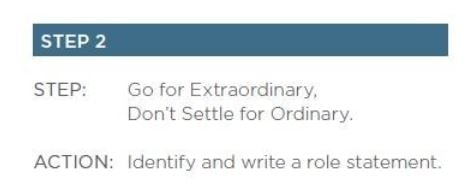 As a leader, your task is to unleash the extraordinary potential of people, but first you need to find out what their potential is. You can discover it by having this conversation: “Imagine meeting yourself when you leave your current role.”
As a leader, your task is to unleash the extraordinary potential of people, but first you need to find out what their potential is. You can discover it by having this conversation: “Imagine meeting yourself when you leave your current role.”
- How have you changed?
- What contributions have you made? How do you know? Have you made a real difference to the organization? To our clients? How would you define and measure that difference?
- Have you given the best that’s in you? Have you brought your best talents, gifts, and creativity to the role? In what ways
Have you felt yourself stretching, growing, and learning? How have you grown? What is the most important thing you’ve learned?
-
-
-
-
Have you felt yourself stretching, growing, and learning? How have you grown? What is the most important thing you’ve learned?
Carry out this experiment for yourself before trying it on others:
-
-
-
-
- Identify the few most important roles you play and write them down. List your work roles and your “outside of work” roles.
- Write a role statement that describes the extraordinary contribution you want to make in each role. Take your time. Don’t just describe what you do now; write down what you want to do in your current role. In this way you’ll tap into your own passion, discovering what really motivates you and how you can create a better world around you and feel accomplished at the end of every day.
-
-
-
Then invite your team to write down the answers to these questions on their own and then share them with you.
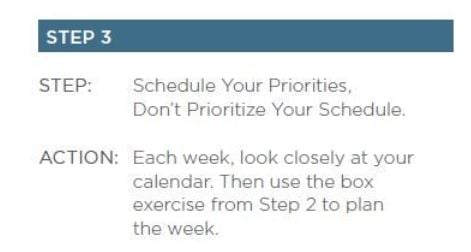
Check off each of the following actions:
-
-
-
- Look at your role statements. What one or two key things can you do this week that will have the most impact on your vision of success? These are your box 2 actions. Schedule them.
- List all other action items and drop them into the boxes.
- Leave box 1 items in your calendar, but ask yourself how you could avoid them in the future. Plan to do so.
- Delete or delegate box 3 items. They are not important.
- Delete box 4 items. They are not important. Make sure you do NOT delete all relaxation, break, or leisure time. This is mostly likely a box 2 time.
-
-
The biggest threat to your productivity is the very technology designed to accelerate it — your smartphone, your laptop, or your tablet. You’re checking your mail, you’re reading it during breakfast, then you’re playing games, surfing, checking out social media, doing research all day. You’re on your smartphone, too, constantly texting, calling people, texting again, and texting some more. At night, the last thing you see as you fall asleep is the glow of a screen. The technology is amazingly useful, but it also distracts us and, even worse, can rule our lives.
Planning turns out to be one of the single most effective strategies you can use in order to reach any goal. According to a FranklinCovey study when people engage in the right kind of planning, their success rates go up on average between 200 percent and 300 percent.
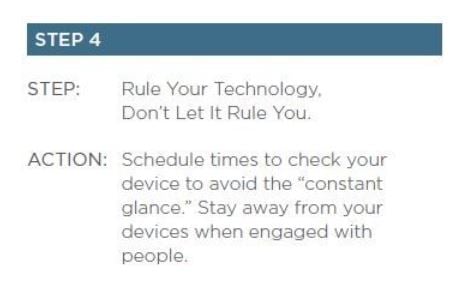
Invite your team to think through their philosophy about technology. How can you use it better? Is your team caught in a web of electronic distractions? How can you eliminate them?
You and your team have a big mission that involves intensive work, so you can’t afford to burn out. Keep the fire burning, but in a balanced way. Brain scientists agree that proper exercise, diet, sleep, relaxation, and human connection recharge and even rejuvenate the brain.
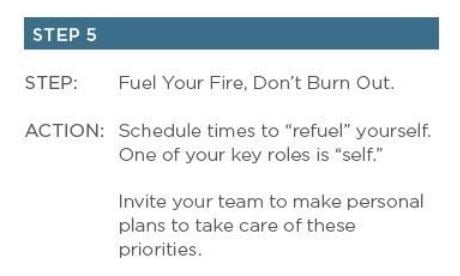
Tapping untold energies:
Scientists tell us there is enough nuclear energy in a few buckets of seawater to power the world for a day — if it could be unleashed. Likewise, there’s enough capability and creativity in each person in your organization to astound you — if you unleash it.